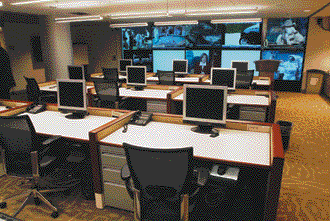Visualize this!

EPA uses videoconferencing for emergency response.
Debris from the space shuttle Columbia rained down on Texas and other areas in 2003 when the spacecraft broke up during re-entry. The Environmental Protection Agency was among those charged with collecting debris and returning it to a NASA hangar for the accident investigation."We worked the Columbia [recovery] for about two weeks. The first couple of days, we worked 24 hours a day," said Christopher Burgess, a specialist with the EPA's Chemical Emergency Preparedness and Prevention Office."We had a mission from Congress and the Federal Emergency Management Agency to do debris cleanup," he said.Both Congress and FEMA were particularly interested in the possible dispersion of hydrazine, which is used in rocket fuel, and some of the other flammable materials that were on the shuttle.Crews and contractors picked up millions of pieces of debris, and EPA monitored the work from an emergency operation center at its Washington headquarters.It quickly became obvious that the emergency center's handful of PCs and speakerphones were not sufficient to handle a major disaster."It was a little cumbersome working in the old emergency center," Burgess said.The agency began work on a new, more ambitious emergency operation center, and some of the most important and visible pieces of technology in the new center are the videoconferencing systems from Tandberg Inc. of New York.Big-screen monitors tile one side of the center's main room, creating a vast wall of video. Several of the screens display satellite feeds of news channels, while two screens are usually reserved for videoconferences over the Tandberg systems.The new center was put to the test when the agency responded to Hurricane Katrina, said Ronald Broadnax, manager of Computer Sciences Corp.'s IT work for the EPA center."We pretty much went full bore for Katrina, responding to spills and looking for environmental issues," Broadnax said. "EPA also goes out and does testing on chemicals found on sites. They do tank clearings, household fuel storage tanks and that sort of thing, as well as collection of refrigerators, washers, dryers, those sorts of things."From the emergency operation center, EPA officials could monitor the progress of contractors, who carried Global Positioning System handheld devices as they walked the affected areas and documented sites in need of cleanup.Some of the video displays have smart-board overlays to let officials mark up images, such as geographic information system views or spreadsheets, and save or send them to people in the field."It's good for any notes that they may want to distribute," said Marvin Anderson, a systems administrator for CSC, such as details on how to implement and initiate a cleanup or information from a meeting.The center can host up to 48 calls, depending on the number of video and audio calls and the total bandwidth in use. It can support both ISDN and IP standards.The Tandberg system has three primary components: infrastructure, management software that ties the pieces together and end-point displays.EPA also uses Tandberg portable devices to let officials in the field participate in videoconferences and transmit video from almost anywhere, said Tim McLain with Tandberg Federal.The Tactical MXP is an integrated video system with a display and camera built into a heavy-duty, watertight case that meets airline specifications."Instead of having a fixed, static situation room, you have these tactical boxes that you can take anywhere in the world and have instant access to a spill or an emergency situation," McLain said.The emergency operation center was so vital and so heavily used during Katrina, EPA officials decided to expand it again. That work is nearing completion and will let more people work in the center when needed.Even though it was designed for emergencies, the center now is being used regularly for cross-regional meetings, project collaboration, training and simulation exercises.While much of the communication necessary during an emergency can be done by phone or e-mail, agencies are realizing that videoconferencing offers a higher level of assistance, McLain said."An e-mail doesn't have the emotion that visual communication does," he said, "and that is how you can really unify an organization ? when you have that immediate visual impact that carries the emotion."

If you have an innovative solution that you installed in a government agency, contact Staff Writer Doug Beizer at dbeizer@postnewsweektech.com.

The EPA's emergency operations center is used to monitor the responses of the agency and its contractors during disasters.
Rick Steele
If you have an innovative solution that you installed in a government agency, contact Staff Writer Doug Beizer at dbeizer@postnewsweektech.com.
NEXT STORY: Ballot-box jitters

